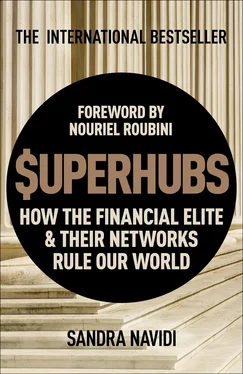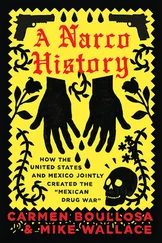Sandra Navidi - SuperHubs - How the Financial Elite and Their Networks Rule our World
Здесь есть возможность читать онлайн «Sandra Navidi - SuperHubs - How the Financial Elite and Their Networks Rule our World» весь текст электронной книги совершенно бесплатно (целиком полную версию без сокращений). В некоторых случаях можно слушать аудио, скачать через торрент в формате fb2 и присутствует краткое содержание. Год выпуска: 2017, Издательство: Hodder & Stoughton, Жанр: Старинная литература, на английском языке. Описание произведения, (предисловие) а так же отзывы посетителей доступны на портале библиотеки ЛибКат.
- Название:SuperHubs: How the Financial Elite and Their Networks Rule our World
- Автор:
- Издательство:Hodder & Stoughton
- Жанр:
- Год:2017
- ISBN:нет данных
- Рейтинг книги:4 / 5. Голосов: 1
-
Избранное:Добавить в избранное
- Отзывы:
-
Ваша оценка:
- 80
- 1
- 2
- 3
- 4
- 5
SuperHubs: How the Financial Elite and Their Networks Rule our World: краткое содержание, описание и аннотация
Предлагаем к чтению аннотацию, описание, краткое содержание или предисловие (зависит от того, что написал сам автор книги «SuperHubs: How the Financial Elite and Their Networks Rule our World»). Если вы не нашли необходимую информацию о книге — напишите в комментариях, мы постараемся отыскать её.
SuperHubs: How the Financial Elite and Their Networks Rule our World — читать онлайн бесплатно полную книгу (весь текст) целиком
Ниже представлен текст книги, разбитый по страницам. Система сохранения места последней прочитанной страницы, позволяет с удобством читать онлайн бесплатно книгу «SuperHubs: How the Financial Elite and Their Networks Rule our World», без необходимости каждый раз заново искать на чём Вы остановились. Поставьте закладку, и сможете в любой момент перейти на страницу, на которой закончили чтение.
Интервал:
Закладка:
The interconnections of the leaders in finance are so numerous, and they overlap in so many industries—in both the private and public sectors—that trying to diagram them is a tedious exercise. Here’s one representative example: The vice chairman of the U.S. Federal Reserve and former central bank governor of the Bank of Israel, Stanley Fischer, was once the MIT professor of former Fed chairman Ben Bernanke and ECB president Mario Draghi. Fischer had previously occupied positions as deputy managing director at the IMF, chief economist at the World Bank, and vice chairman at Citigroup. His students also included former U.S. treasury secretary Larry Summers and Greg Mankiw, who chaired the Council of Economic Advisers during the administration of George W. Bush. Fischer had also been in the running to become IMF chief when Dominique Strauss-Kahn resigned, and Fed chairman after the end of Bernanke’s term. Fischer’s, Bernanke’s, and Draghi’s aligned thinking was reflected in their similar approach to quantitative easing during the financial crisis and in its aftermath. The central bank governor of the Bank of England during the crisis was Mervyn King, who had also once taught in MIT’s economics department. It is quite incredible how much our world has been shaped by the few who attended the same school.
The epitome of the old boys’ network is Goldman Sachs. It is the most exclusive of all exclusive clubs and artfully illustrates how the power-laws of network science correlate with actual network power. Due to the fact that Goldman always seems to make money regardless of the circumstances, it has been vilified as the “great vampire squid wrapped around the face of humanity”17 and alleged to have caused as well as profited from various financial crises. Goldmanites are everywhere, as the firm hires former high-level public sector employees, and partners leave the firm to take public office.
In the time leading up to the financial crisis, Robert Rubin, previously co-CEO of Goldman Sachs, served as secretary of the U.S. treasury under President Bill Clinton. During the crisis, Hank Paulson, then CEO of Goldman Sachs, became the next U.S. treasury secretary. The president of the European Central Bank, Mario Draghi, was once vice chairman and managing director of Goldman Sachs International. Mario Monti, prime minister of Italy from 2011 to 2013, worked as an adviser for Goldman Sachs. Robert Zoellick went from being Goldman Sachs’s head of international affairs to president of the World Bank. From there he returned to Goldman and became chairman of the international advisory board. The German government awarded him the Federal Cross of Merit for his services regarding the German reunification.
Speaking of Germany, its government was heavily criticized for providing too much top-level government access to Goldman Sachs, which the political opposition labeled the “bonus program for investment bankers.” Prior Goldman Sachs employees have also obtained high-level government positions throughout the world. Numerous other influential and famous Goldmanites include John Thain (former chairman and CEO of CIT Group, former president and co-CEO of Goldman Sachs), Jon Corzine (CEO of MF Global, former U.S. senator of New Jersey, former CEO of Goldman Sachs), Duncan Niederauer (former CEO of NYSE Group, former partner at Goldman Sachs Group), Joshua Bolten (White House chief of staff to U.S. President George W. Bush, former executive director for legal and government affairs at Goldman Sachs), and countless more.
That’s Rich: Superhubs and Super-Riches
One thing that nearly all top financial executives have in common is great wealth, which is a measurable, publicly known yardstick for success. Together they can increase their financial muscle even more, be it for political influence, charities, or otherwise. Although they are active in different fields, they are united by the privileges and problems that wealth creates.
Policy makers are not part of this particular sphere, as they make substantially less money than hedge fund titans, private equity kings, or bank CEOs. For instance, Fed Chair Janet Yellen in 2015 received a salary of roughly $200,000, and Christine Lagarde, Managing Director of the IMF, was compensated with close to $500,000. However, since the lack of financial clout can be compensated for by other factors such as power and status, they remain firmly entrenched in the center of the financial network. Similarly, academics, intellectuals, and top service providers are part of the mix, because their commonalities outweigh their differences. Still, compensation remains a powerful common denominator among superhubs that allows them to perpetuate their exclusive microcosm.
CEOs in the financial industry continue to make headlines with their almost outrageously high remuneration, which outpaces overall Wall Street pay. Their ever-skyrocketing compensation is a manifestation of the superstar economy as well as the superstar CEO. The term “economics of superstars” was coined in the early eighties by Sherwin Rosen, an economist at the University of Chicago. He argued in a widely recognized paper that technological progress would provide the best performers with greater market access and, as a consequence, disproportionate pay.18 This dynamic explains the megapay of successful athletes, actors, and musicians, and Sherwin’s prescient theory also applies to similar trends in the financial world. As economies grew, banks morphed into monstrous global conglomerates, and investment funds began to manage trillions of dollars. Fierce competition for the best human capital ensued, and compensation increased to previously unimagined heights to meet the demand. CEOs developed superstar brands in their own right with public relations campaigns, TV interviews, and industry awards. Pay packages are exceedingly high on an absolute basis, as well as relative to other executives.
Financiers generally believe that compensation is purely performance based and, because it is measurable in terms of profits, well deserved. However, in the complex and opaque world of finance, objective performance measurement is challenging. There are many unknown variables beyond executive control, such as the blowup of a previously hailed asset class, like energy, or the bursting of a bubble like the Internet. A systemic financial crisis may even reveal that all asset classes are in fact negatively correlated. The application of performance metrics has been questioned in view of the recent billion-dollar losses and fines ranging in the hundreds of millions. Yet, CEOs still receive rising pay.
Proponents argue that winner-takes-all compensation is simply the result of market forces and freely agreed contracts, and that competitive salaries are necessary to obtain and retain top talent. According to them, paying finance executives handsomely is less costly and disruptive than losing them. Critics counter that financial CEOs are self-interested and biased toward perpetuating the upward pay spiral. They run the companies that pay them and often chair the boards that determine their own remuneration. The National Bureau of Economic Research suggests that rising salaries are the result of contagion, because boards are influenced by the higher pay awarded by other companies.19 Rather than traditional compensation for services rendered, today’s pay packages have aptly been described as resembling prizes won at tournaments.20
Of course, circumstances vary depending on the nature of the financial institution. A publicly traded bank is accountable to its shareholders. Hedge fund founders—such as George Soros, Steve Cohen, and Stan Druckenmiller—manage their own multibillion-dollar fortunes and, therefore, are accountable to only themselves. Other hedge funds that manage billions on behalf of pension funds, insurance companies, and other big investors are often founder- or partner-owned. Their fees and compensation parameters are relatively clear-cut and transparent. The same generally applies to private equity, although the industry has recently come under scrutiny by the Securities and Exchange Commission (SEC) regarding hidden fees.
Читать дальшеИнтервал:
Закладка:
Похожие книги на «SuperHubs: How the Financial Elite and Their Networks Rule our World»
Представляем Вашему вниманию похожие книги на «SuperHubs: How the Financial Elite and Their Networks Rule our World» списком для выбора. Мы отобрали схожую по названию и смыслу литературу в надежде предоставить читателям больше вариантов отыскать новые, интересные, ещё непрочитанные произведения.
Обсуждение, отзывы о книге «SuperHubs: How the Financial Elite and Their Networks Rule our World» и просто собственные мнения читателей. Оставьте ваши комментарии, напишите, что Вы думаете о произведении, его смысле или главных героях. Укажите что конкретно понравилось, а что нет, и почему Вы так считаете.












